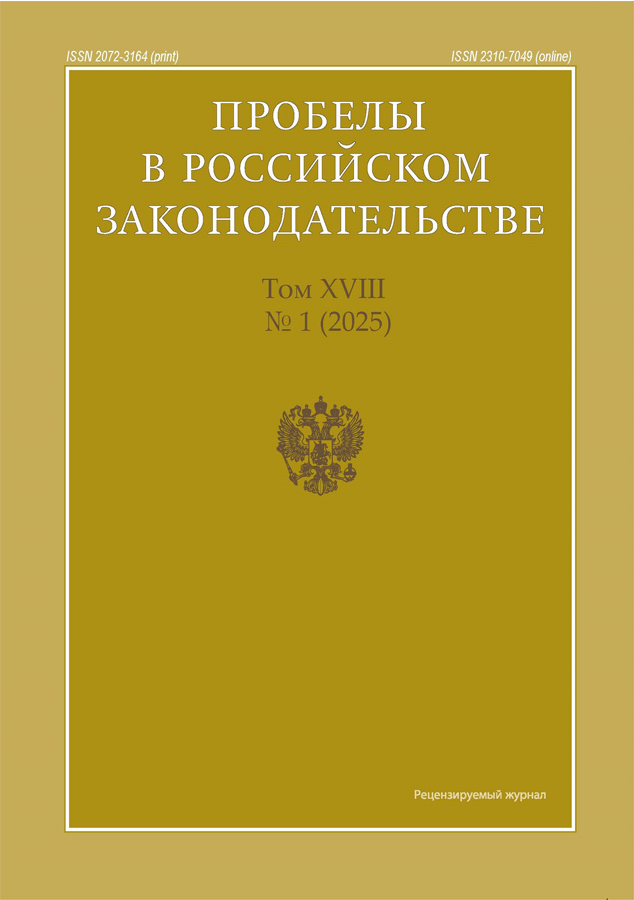Modeling in the law enforcement sphere: the main directions of implementation in modern conditions
- Autores: Korobov V.B.1, Kobozev A.A.2
-
Afiliações:
- All-Russian Research Institute of the Ministry of Internal Affairs of Russia
- All-Russian Institute for Advanced Training of Employees of the Ministry of Internal Affairs of Russia
- Edição: Volume 18, Nº 1 (2025)
- Páginas: 46-50
- Seção: Public Law (State Law) Sciences
- URL: https://journals.eco-vector.com/2072-3164/article/view/677698
- DOI: https://doi.org/10.33693/2072-3164-2025-18-1-46-50
- EDN: https://elibrary.ru/VJUEMS
- ID: 677698
Citar
Resumo
The article substantiates the idea of the need for a wider use of the modeling method in the law enforcement sphere. From the point of view of the authors, the theory and methodology of modeling as a management tool allows not only to identify organizational problems accumulated in the law enforcement sphere, but also to determine the necessary measures to eliminate them, optimize the existing model of the law enforcement system. The work reveals a set of negative factors that hinder the effective development of the law enforcement sphere. In particular, the thesis is argued that a traditional model of law enforcement activity has been formed in the country, focused mainly on formal performance indicators and weak interaction with the public. The relevance of the formation of a socially oriented model of the law enforcement system is emphasized as the only source of rehabilitation of the law enforcement sphere and increasing its effectiveness.
Texto integral
Sobre autores
Viktor Korobov
All-Russian Research Institute of the Ministry of Internal Affairs of Russia
Email: kvbdoc@yandex.ru
Código SPIN: 7347-1223
Dr. Sci. (Sociolog.), Prof., Chief researcher of scientific research center 2
Rússia, MoscowAleksey Kobozev
All-Russian Institute for Advanced Training of Employees of the Ministry of Internal Affairs of Russia
Autor responsável pela correspondência
Email: aleksey-kobozev@mail.ru
Código SPIN: 9352-1517
Cand. Sci. (Law), Assoc. Prof., senior researcher of the research department
Rússia, DomodedovoBibliografia
- Andreev N. A., Korobov V. B., Filimonov O. V. Social partnership in law enforcement. Monograph. — M.: Academy of Management of the Ministry of Internal Affairs of Russia, 2015. 171 p.
- Ivanilov Yu. P., Lotov A. V. Mathematical models in economics: textbook. handbook for universities.Ed. [and with a preface] by N. N. Moiseev. Moscow: Nauka, Chief Editor of Physical and Mathematical literature, 1979. 304 p.
- Ivanova I. G., Plotnikov A. V., Vizer V. V. The role of modeling in the study of control systems. Actual issues of economic sciences. Scientific journal. 2016. No. 50–1. Pp. 60–63.
- Isenko A. I. Concepts of model and modeling in human activity // Concept. Scientific and methodological electronic journal. 2015. No. 4. Pp. 31–35 // URL: https://e-koncept.ru/2015/ 15095.htm (Accessed: 12/12/2024).
- Kudryavtsev V. N. Crime control strategies / RAS. 2nd ed., revised. and enlarged. — Moscow: Nauka, 2005. 366 p.
- Nikitina E. E., Kuznetsov V. I. Regulatory Models of Interaction between the State and Non-Profit Organizations in the Defense and Security Sphere in the Russian Federation. Zhurnal rossijskogo prava // Journal of Russian Law, 2020, no. 4, Pp. 88–104. 7. Пешель М. Моделирование сигналов и систем / пер. с нем. под ред. Я. И. Хургина. — М.: «Мир», 1981. 300 с.
- Состояние преступности в России за январь—декабрь 2023 года. — М.: ГИАЦ МВД России, 2024. 68 с.
- Состояние преступности в России за январь—сентябрь 2024 года. — М.: ГИАЦ МВД России, 2024. 68 с.
Arquivos suplementares









